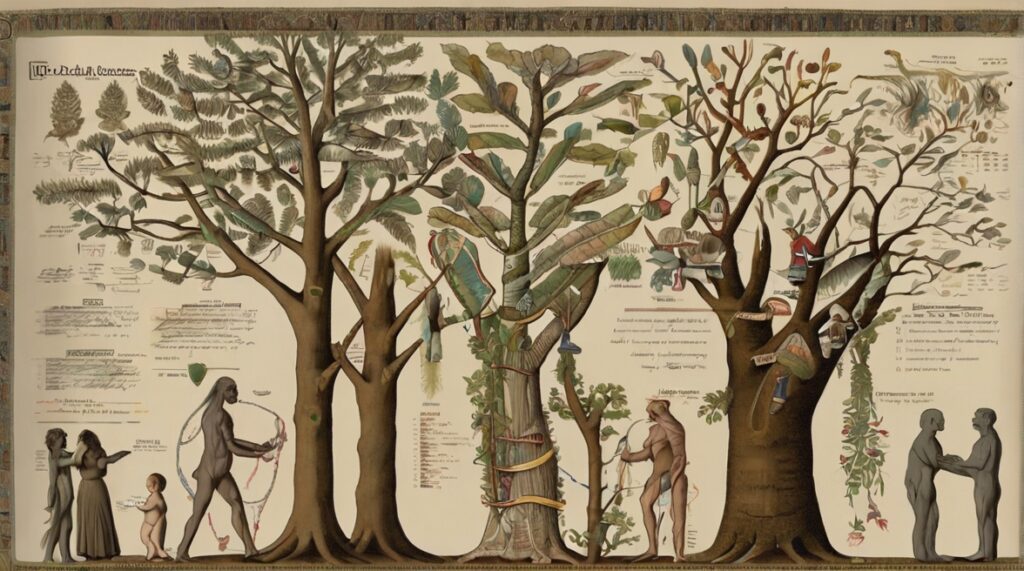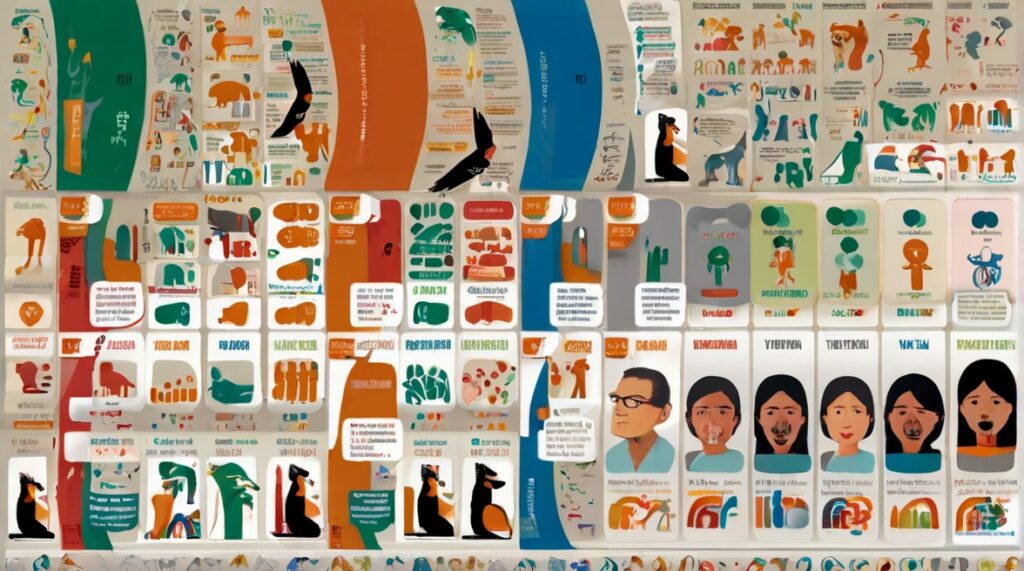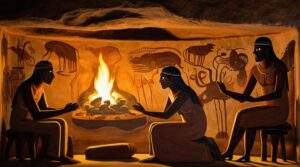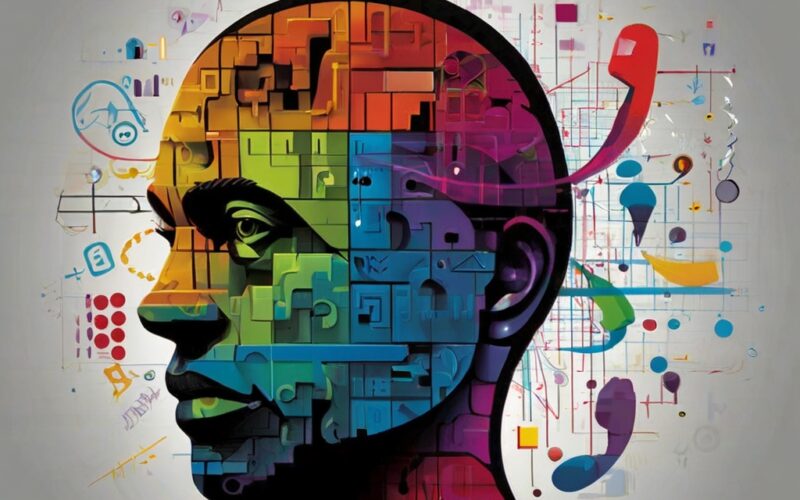Preface
At the dawn of humanity, snuggled within the cradle of African continent, our ancestors gazed upon the stars and patterns of nature with wonder. This sense of awe and curiosity laid the groundwork for a journey—a symphony of intellectual and cultural evolution that has spanned tens of millennia. This essay embarks on an exploration of three pivotal forces that have shaped human experience: mathematics, language, and storytelling.
Mathematics emerged as the universal language of the cosmos, a tool for deciphering the patterns woven into the fabric of reality. Language, in its myriad forms, became the medium through which we express, communicate, and understand our world and each other. Storytelling, the art of narrative, has allowed us to transcend time and place, to create myths, and to share our dreams, fears, victories, and defeats.
Together, these three elements form an evolutionary symphony, each movement reflecting a step forward in our collective journey. From the simple act of counting to the complexities of abstract thought, from the first uttered words to the profound narratives that define cultures, this symphony narrates the story of us.
Join me on this journey through time, as we uncover the harmonious blend of logic, expression, and imagination that has propelled humanity forward.
Mathematics, The Language of Nature’s Patterns
Patterns play a pivotal role in human experience. Our survival hinges on our ability to perceive and react to the world’s tempos. Though each day brings its changes, we depend on certain constants: the sunrise, the sunset, the sky above us, the flow of water. These and countless other recurring patterns significantly shape our actions. Instincts are vital, and memory is crucial because these patterns are enduring.

Mathematics serves as the language of these patterns. With just a few symbols, mathematics allows us to capture these patterns with both precision and symbolism. Galileo famously stated that the book of nature, which he believed revealed the divine as surely as the scriptures, is written in the language of mathematics. In the centuries since, scholars have engaged in a secular interpretation of this idea. They question whether mathematics is a tool created by humans to describe the patterns we observe or if it is the underlying fabric of reality, making the world’s patterns manifestations of mathematical truths. It’s a captivating thought that our mathematical endeavors could connect us directly to the foundation of reality. However, there’s also the perspective that mathematics is a construct of human invention, shaped by our inclination towards identifying patterns. Indeed, much of mathematical theory does not directly contribute to basic survival needs, such as obtaining food or reproducing, suggesting that it may extend beyond mere practicality in our ancestors’ lives.
Language, The Conduit of Imagination and Understanding
In the contemporary era, Albert Einstein’s unmatched genius in cracking the universe’s mysteries has set an awesome benchmark. His profound contributions to our understanding of the cosmos are encapsulated in a mere handful of mathematical expressions. Yet, Einstein’s journey into the depths of the universe did not solely rely on equations or conventional language. He famously stated, “I often think in music. I very rarely think in words at all.” This statement suggests a thought process that transcends the conventional bounds of language, illustrating that deep insights into reality can stem from outside the verbal domain. While Einstein found solace in the abstract realms of music, others, me included, find language indispensable. Despite recognizing the truth in Ludwig Wittgenstein’s assertion that “The limits of my language mean the limits of my world,” I acknowledge the existence of thoughts and experiences that elude linguistic capture. Yet, without language, my ability to navigate complex conceptual landscapes would be significantly curtailed. Language not only serves as a vehicle for articulation but also invigorates and shapes thought, echoing Toni Morrison’s sentiment that while our mortal fate is sealed, our engagement with language defines the essence of our existence.
Beyond the realm of individual genius, language is a catalyst for unleashing the imagination. It allows us to envision possibilities that extend far beyond the confines of our immediate reality, to conjure vivid imagery in the minds of others, near and far. Through language, we transmit knowledge, simplifying the learning process and broadening the horizons of understanding. It enables us to synchronize efforts, merge our creative energies into a powerful collective force, and recognize our capacity to surpass mere survival instincts. Astonishingly, a complex array of sounds can capture profound truths about the universe, evoke the nuances of love and loss, and construct a shared narrative that lends coherence to our collective experience. Language, in its myriad forms, invites us to partake in the grand story of humanity, winding together a plethora of stories that illuminate the human condition and our place within the cosmos.
The Mystery of Language’s Origins
The origins and evolution of language remain shrouded in mystery and speculation. Charles Darwin theorized that language might have its roots in musical expression, suggesting that individuals with exceptional vocal abilities, akin to those of a Sinatra, would have a reproductive advantage, leading over generations to the transformation of melodious sounds into structured words. Contrarily, Alfred Russel Wallace, Darwin’s contemporary, and co-pioneer of the theory of natural selection, advanced that natural selection alone could not account for the human capacities for music and language. He argued that these complex forms of communication could not have offered a significant survival advantage and thus must have been influenced by a higher power, a notion that deeply unsettled Darwin.

In the almost two centuries since Darwin and Wallace, numerous theories have been proposed regarding the genesis and development of language, yet none have reached a consensus. This contrasts sharply with our understanding of the universe’s early development, which, despite its vast scale, is supported by a wealth of empirical evidence, such as the cosmic microwave background radiation and the distribution of elemental atoms. The ephemeral nature of sound waves, the primary carriers of language, leaves no physical trace for scientists to study, resulting in a diverse array of theories based largely on conjecture.
Despite the debates surrounding its inception, there is a broad agreement that human language is distinctively complex compared to other forms of animal communication. Unlike the fixed calls of other species, human language is dynamic, allowing for an infinite recombination of a limited set of phonemes to express an endless array of ideas. This capacity for linguistic creativity raises further questions: Is our brain uniquely wired for language acquisition, or is it the result of cultural immersion and a general ability to learn? Did language start as simple vocalizations with specific meanings that evolved into more complex structures, or did it begin with basic sounds that coalesced into words and sentences? Moreover, the ultimate purpose of language—whether it was directly selected for by evolution due to its survival benefits or is a byproduct of other evolutionary changes, such as increased brain size—remains a topic of intense debate.
Noam Chomsky, a towering figure in modern linguistics, argues that humans possess an innate universal grammar, a concept echoing insights from as far back as the thirteenth century, suggesting that the diverse languages of the world are built upon a shared structural core. This theory of universal grammar has sparked considerable debate, proposing at its core that our neurobiological architecture equips us with a linguistic primer. This innate capacity enables us to absorb, comprehend, and articulate language, raising the question of how children, amidst the chaotic and fragmented input of daily life, manage to master complex grammatical rules without a pre-existing mental framework tailored to language learning. This framework, according to Chomsky, is not tailored to any specific language but is capable of adapting to the universal elements present in all languages. He speculates that a pivotal neurobiological development, possibly occurring around eighty thousand years ago, might have endowed our ancestors with this linguistic capacity, catalyzing a cognitive explosion that disseminated language throughout the human species.
Conversely, a Darwinian perspective, advocated by Steven Pinker among others, views language as the product of gradual evolutionary advancements, each conferring a survival benefit. This viewpoint suggests that the ability to communicate was crucial for the cohesion and effectiveness of early human groups, facilitating the transmission of knowledge. Consequently, individuals with enhanced communicative abilities gained a selective advantage, leading to the proliferation and refinement of linguistic skills across generations. Additionally, researchers have identified a range of adaptations—such as breath control, memorization, symbolic thinking, and social cohesion—that, while not directly selected for language, collectively contributed to its emergence. These adaptations may have supported the development of language even if the survival value of language itself was incidental.
The Origins of Human Speech

The timeline of human speech remains an enigma, with linguistic traces from ancient times virtually non-existent. However, by analyzing plausible archaeological proxies, researchers have proposed estimates for the inception of language. Artifacts such as hafted tools, cave paintings, geometric engravings, and beadwork suggest that as far back as one hundred thousand years ago, our ancestors engaged in activities requiring planning, symbolic thought, and complex social interactions. These advanced cognitive abilities are likely intertwined with the development of language, leading us to speculate that early humans were already communicating about their daily lives and communal plans.
Further insights into the capacity for speech come from a diverse array of archaeological evidence. Studies tracking the expansion of cranial cavities alongside morphological changes in the mouth and throat regions suggest that our predecessors had the physical capability for speech potentially over a million years ago, provided they were so inclined. Molecular biology has also shed light on this mystery. The complex vocal and oral dexterity required for human speech appears to have a genetic underpinning, as demonstrated in 2001 when researchers studying a British family affected by a hereditary speech disorder pinpointed a genetic anomaly. A single nucleotide alteration in the FOXP2 gene, located on human chromosome 7, was identified as a common factor among family members with the disorder, thereby implicating it in the disruption of language and speech capabilities. Consequently, FOXP2 has been recognized as a crucial gene for normal speech and language development.
Interestingly the FOXP2 gene exhibits slight variations across a wide array of species, from chimpanzees to birds to fish. This diversity enables scientists to chart the gene’s evolutionary trajectory. Interestingly, the protein produced by the chimpanzee FOXP2 gene differs from the human version by merely two amino acids out of more than seven hundred, indicating a close genetic relationship. Whereas the Neanderthal version of the FOXP2 gene is identical to the human gene, raising intriguing questions about the linguistic capabilities of our ancient relatives. This genetic evidence suggests that the foundational elements for speech and language were established after our lineage diverged from that of chimpanzees, several million years ago, but before our separation from Neanderthals, approximately six hundred thousand years ago.
This timeframe, derived from a combination of historical markers including ancient artifacts, physiological adaptations, and genetic discoveries, suggests that the emergence of the world’s first words could span from a few tens of thousands to several million years ago. However, the precise inception of language remains elusive, compounded by the distinction between possessing the physical and cognitive capacity for speech and the actual utilization of this capacity. The transition from potential to practice in the realm of speech invites further exploration into what might have prompted our ancestors to start communicating through language.
Why We Moved from Gestures to Speech
The genesis of spoken language among our early ancestors is a topic rife with theories. Our nonhuman primate relatives, despite their lack of a spoken language, demonstrate the ability to convey basic ideas through gestures. Research in controlled environments has shown that chimpanzees can learn to use hundreds of hand signs to communicate about various actions, objects, and concepts. This suggests that our ancestors’ shift to spoken language could have evolved from an initial phase of gesture-based communication. As the use and creation of tools increasingly engaged our hands, and as social gatherings grew in complexity making gestures less practical, vocalization likely became a more efficient method for information exchange. This theory, like many others regarding the origins of language, highlights the transition towards the spoken word.
Despite the mysteries surrounding the inception of language, one undeniable truth is the profound impact of language and thought when combined. Whether an internalized form of language existed before its vocal expression, or whatever may have triggered such vocalization, the introduction of language to the human mind set the stage for a profound transformation in our interaction with the world. This transformation was significantly propelled by one of humanity’s most enduring and impactful behaviors: storytelling.
From Speech to The Storytelling Instinct

The “Epic of Gilgamesh,” a narrative hailing from Mesopotamia and penned in the third millennium BC, stands as the earliest known story of our species. This enduring tradition of storytelling, whether to subtly reshape reality, to amplify drama, for historical preservation, or simply for the pleasure of crafting tales, has been a constant through the ages. Despite the vast changes in our ways of living, communicating, and even in our approaches to health and reproduction over the millennia, the narrative of Gilgamesh—with its themes of conflict, ambition, rivalry, and the spectrum of human emotions—remains relatable to us today.
Our capacity to feel and express a broad range of emotions such as sorrow, joy, love, and curiosity is paralleled by a compulsion to capture these experiences in stories. The existence of “Gilgamesh” as a written record implies that storytelling predates its creation, highlighting storytelling as a fundamental human activity. This leads to the intriguing question: Why do we prioritize storytelling over more immediate survival activities like hunting or gathering? The answer extends beyond a simple affinity for narrative; evolutionary psychologists suggest a deeper, more ingrained rationale.
This inquiry delves into whether Darwinian evolution can shed light on our predilection for storytelling, particularly when such tales do not ostensibly contribute to our survival. The fascination with fictional narratives, following the trials of non-existent characters in fabricated settings, presents an evolutionary conundrum. Evolution, with its capacity to weed out non-advantageous traits, should theoretically favor genetic mutations that divert our energies from storytelling to more survival-oriented tasks. Yet, the storytelling instinct has persisted, indicating that, contrary to expectations, it has not been deemed extraneous by evolutionary processes, or perhaps it represents an evolutionary nuance that remains unexplored.
Efforts to puzzle out the evolutionary roots of storytelling face significant challenges, primarily due to the scarcity of direct evidence from our distant past. Establishing the prevalence or utility of storytelling among our ancestors, who lived thousands of generations ago, demands an intimate grasp of their mental landscapes and environmental contexts. However, the documented history captures merely the last fraction of the approximately two million years since early humans embarked on their migration out of Africa. Despite this, a mosaic of evidence provides enough framework to foster semi-informed theories on the matter.
One possibility is that storytelling emerged not as a direct evolutionary advantage but as a collateral effect of other adaptive developments favored by natural selection. The complexity of evolutionary processes precludes selective interpretation; evolution often delivers comprehensive packages rather than isolated traits. The advanced, neuron-rich human brain, while primarily a survival tool, might inherently delight in narrative. Skeptics argue, however, that if storytelling were merely peripheral to human activity, evolutionary mechanisms would likely have eliminated such an energetically costly habit.
The challenge in attributing adaptive narratives to behaviors lies in our inability to experimentally recreate evolutionary scenarios. The most persuasive theories link specific adaptive challenges directly to behaviors that appear optimally designed to address those challenges. For example, the human predisposition for sugar-rich foods is a straightforward survival adaptation. The question then arises: are there similar evolutionary reasons behind the human inclination to invent, share, and consume stories?
Indeed, there are compelling arguments for storytelling as a form of mental rehearsal for real-life situations, allowing individuals to simulate and refine strategies for dealing with life’s uncertainties. Renowned psychologist Steven Pinker suggests that stories serve as a mental repository of potential solutions to challenges, offering a resource we can draw upon when confronted with dilemmas. This cognitive engagement with fiction could provide a cost-effective, safe, and efficient method for expanding the mind’s experiential base.
Furthermore, storytelling transcends the realm of individual cognition to become a profoundly social medium. It stands as our most effective tool for understanding the perspectives of others. In a species as inherently social as ours, the capacity to empathize and temporarily inhabit the minds of others could have been critical to our survival and ascendancy. This perspective highlights a potential evolutionary basis for embedding storytelling within the human behavioral repertoire, underscoring its adaptive value.
Conclusion
We have seen how in the scheme of human evolution, the threads of mathematics, language, and storytelling weave a complex narrative that defines our species. From the primal rhythms of nature to the abstract constructs of mathematics, we have sought to understand the world around us. Language emerged as a powerful tool, not just for communication but as a conduit for imagination and understanding, bridging the gap between the tangible and the intangible, the known and the unknown.
The origins of language and speech, cloaked in mystery, reflect our ancestors’ journey from gesture-based communication to the rich expression of spoken word, driven by the necessity of more efficient information exchange and the complexities of social interactions. This evolution set the stage for the birth of storytelling, a uniquely human trait that has persisted through millennia, from the ancient epic of Gilgamesh to the narratives that shape our world today.
Storytelling, rooted deeply in our evolutionary past, serves not just as entertainment but as a crucial mechanism for survival, allowing us to simulate and strategize, to empathize and connect, and to pass on knowledge and cultural heritage. It is through stories that we navigate the complexities of human existence, exploring the myriad facets of life, love, conflict, and the quest for understanding.
As we stand on the shoulders of giants like Darwin, Chomsky, and Pinker, we recognize that the impulse to tell stories is not a mere byproduct of evolution but a key feature of our humanity. It is storytelling that has enabled us to conquer the realms of the unknown, to dream of worlds beyond our immediate grasp, and to forge connections that transcend time and space.
In conclusion, the journey from the language of nature’s patterns to the narratives that define our existence underscores the profound interconnection between mathematics, language, and storytelling in the human chronicle. These elements, together, form the bedrock of our cognitive and social evolution, shaping the essence of what it means to be human. As we continue to explore the mysteries of the universe and the intricacies of the human mind, we carry forward the legacy of our ancestors, forever bound by the timeless art of storytelling.







